Akos F. Kungl
Weight transport through spike timing for robust local gradients
Mar 04, 2025Abstract:In both machine learning and in computational neuroscience, plasticity in functional neural networks is frequently expressed as gradient descent on a cost. Often, this imposes symmetry constraints that are difficult to reconcile with local computation, as is required for biological networks or neuromorphic hardware. For example, wake-sleep learning in networks characterized by Boltzmann distributions builds on the assumption of symmetric connectivity. Similarly, the error backpropagation algorithm is notoriously plagued by the weight transport problem between the representation and the error stream. Existing solutions such as feedback alignment tend to circumvent the problem by deferring to the robustness of these algorithms to weight asymmetry. However, they are known to scale poorly with network size and depth. We introduce spike-based alignment learning (SAL), a complementary learning rule for spiking neural networks, which uses spike timing statistics to extract and correct the asymmetry between effective reciprocal connections. Apart from being spike-based and fully local, our proposed mechanism takes advantage of noise. Based on an interplay between Hebbian and anti-Hebbian plasticity, synapses can thereby recover the true local gradient. This also alleviates discrepancies that arise from neuron and synapse variability -- an omnipresent property of physical neuronal networks. We demonstrate the efficacy of our mechanism using different spiking network models. First, we show how SAL can significantly improve convergence to the target distribution in probabilistic spiking networks as compared to Hebbian plasticity alone. Second, in neuronal hierarchies based on cortical microcircuits, we show how our proposed mechanism effectively enables the alignment of feedback weights to the forward pathway, thus allowing the backpropagation of correct feedback errors.
Versatile emulation of spiking neural networks on an accelerated neuromorphic substrate
Dec 30, 2019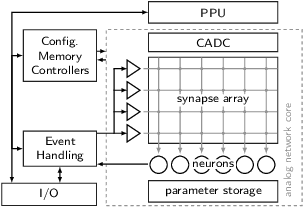
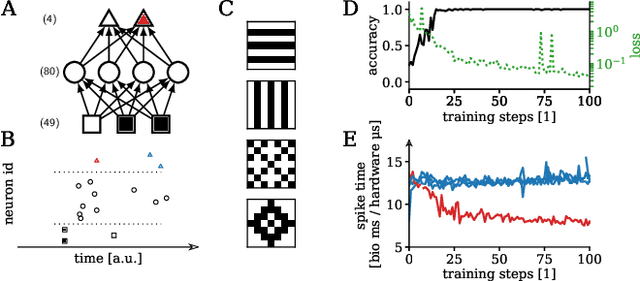
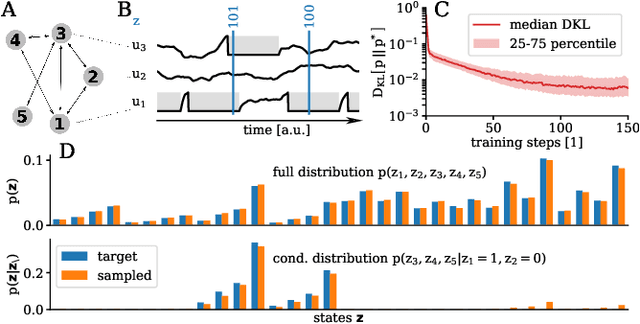
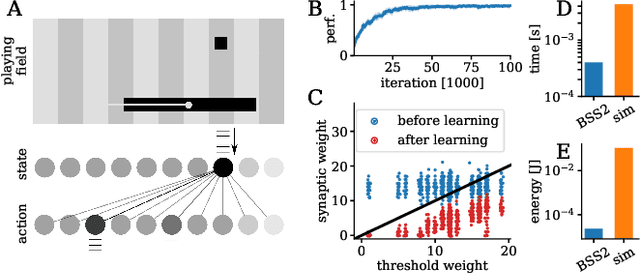
Abstract:We present first experimental results on the novel BrainScaleS-2 neuromorphic architecture based on an analog neuro-synaptic core and augmented by embedded microprocessors for complex plasticity and experiment control. The high acceleration factor of 1000 compared to biological dynamics enables the execution of computationally expensive tasks, by allowing the fast emulation of long-duration experiments or rapid iteration over many consecutive trials. The flexibility of our architecture is demonstrated in a suite of five distinct experiments, which emphasize different aspects of the BrainScaleS-2 system.
Brain-Inspired Hardware for Artificial Intelligence: Accelerated Learning in a Physical-Model Spiking Neural Network
Oct 01, 2019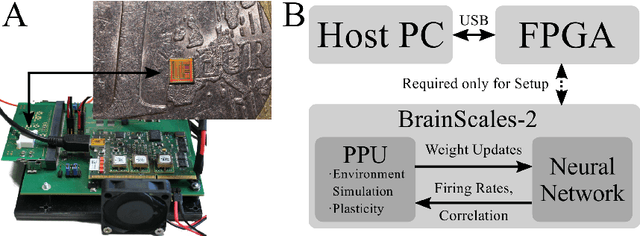
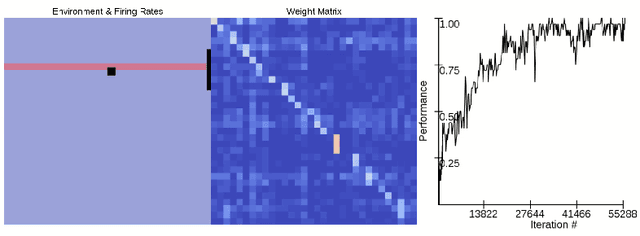
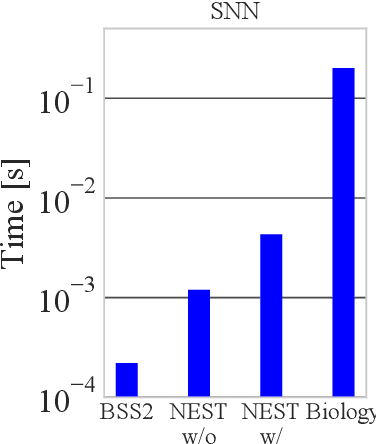
Abstract:Future developments in artificial intelligence will profit from the existence of novel, non-traditional substrates for brain-inspired computing. Neuromorphic computers aim to provide such a substrate that reproduces the brain's capabilities in terms of adaptive, low-power information processing. We present results from a prototype chip of the BrainScaleS-2 mixed-signal neuromorphic system that adopts a physical-model approach with a 1000-fold acceleration of spiking neural network dynamics relative to biological real time. Using the embedded plasticity processor, we both simulate the Pong arcade video game and implement a local plasticity rule that enables reinforcement learning, allowing the on-chip neural network to learn to play the game. The experiment demonstrates key aspects of the employed approach, such as accelerated and flexible learning, high energy efficiency and resilience to noise.
Demonstrating Advantages of Neuromorphic Computation: A Pilot Study
Nov 29, 2018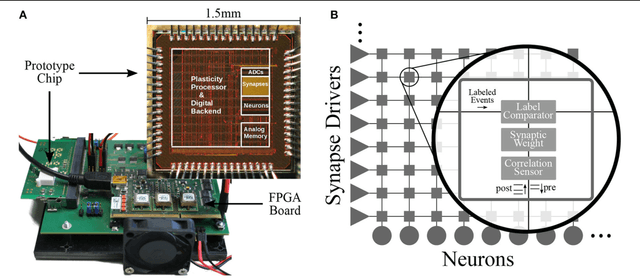
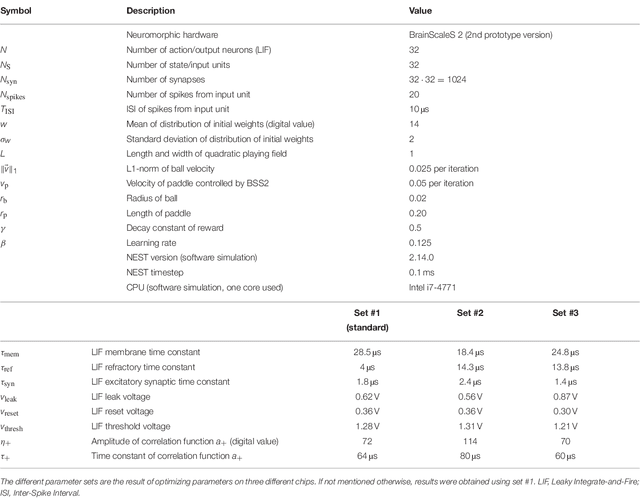
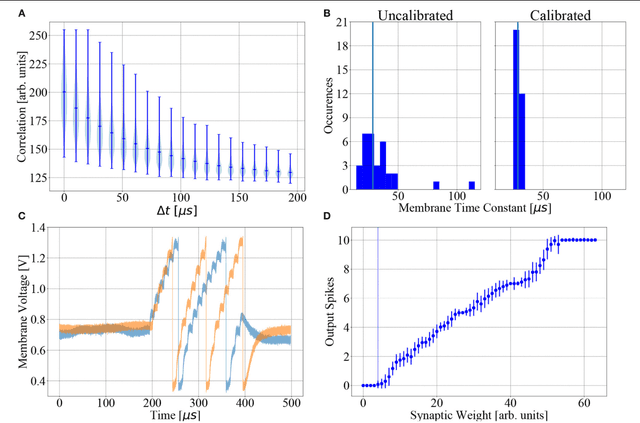
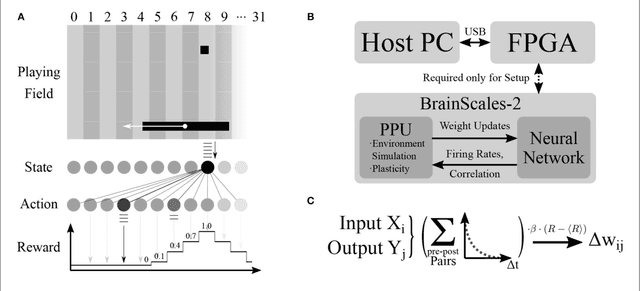
Abstract:Neuromorphic devices represent an attempt to mimic aspects of the brain's architecture and dynamics with the aim of replicating its hallmark functional capabilities in terms of computational power, robust learning and energy efficiency. We employ a single-chip prototype of the BrainScaleS 2 neuromorphic system to implement a proof-of-concept demonstration of reward-modulated spike-timing-dependent plasticity in a spiking network that learns to play the Pong video game by smooth pursuit. This system combines an electronic mixed-signal substrate for emulating neuron and synapse dynamics with an embedded digital processor for on-chip learning, which in this work also serves to simulate the virtual environment and learning agent. The analog emulation of neuronal membrane dynamics enables a 1000-fold acceleration with respect to biological real-time, with the entire chip operating on a power budget of 57mW. Compared to an equivalent simulation using state-of-the-art software, the on-chip emulation is at least one order of magnitude faster and three orders of magnitude more energy-efficient. We demonstrate how on-chip learning can mitigate the effects of fixed-pattern noise, which is unavoidable in analog substrates, while making use of temporal variability for action exploration. Learning compensates imperfections of the physical substrate, as manifested in neuronal parameter variability, by adapting synaptic weights to match respective excitability of individual neurons.
Stochasticity from function - why the Bayesian brain may need no noise
Sep 21, 2018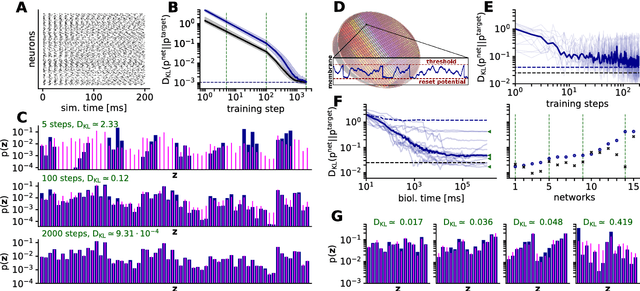
Abstract:An increasing body of evidence suggests that the trial-to-trial variability of spiking activity in the brain is not mere noise, but rather the reflection of a sampling-based encoding scheme for probabilistic computing. Since the precise statistical properties of neural activity are important in this context, many models assume an ad-hoc source of well-behaved, explicit noise, either on the input or on the output side of single neuron dynamics, most often assuming an independent Poisson process in either case. However, these assumptions are somewhat problematic: neighboring neurons tend to share receptive fields, rendering both their input and their output correlated; at the same time, neurons are known to behave largely deterministically, as a function of their membrane potential and conductance. We suggest that spiking neural networks may, in fact, have no need for noise to perform sampling-based Bayesian inference. We study analytically the effect of auto- and cross-correlations in functionally Bayesian spiking networks and demonstrate how their effect translates to synaptic interaction strengths, rendering them controllable through synaptic plasticity. This allows even small ensembles of interconnected deterministic spiking networks to simultaneously and co-dependently shape their output activity through learning, enabling them to perform complex Bayesian computation without any need for noise, which we demonstrate in silico, both in classical simulation and in neuromorphic emulation. These results close a gap between the abstract models and the biology of functionally Bayesian spiking networks, effectively reducing the architectural constraints imposed on physical neural substrates required to perform probabilistic computing, be they biological or artificial.
Generative models on accelerated neuromorphic hardware
Jul 11, 2018



Abstract:The traditional von Neumann computer architecture faces serious obstacles, both in terms of miniaturization and in terms of heat production, with increasing performance. Artificial neural (neuromorphic) substrates represent an alternative approach to tackle this challenge. A special subset of these systems follow the principle of "physical modeling" as they directly use the physical properties of the underlying substrate to realize computation with analog components. While these systems are potentially faster and/or more energy efficient than conventional computers, they require robust models that can cope with their inherent limitations in terms of controllability and range of parameters. A natural source of inspiration for robust models is neuroscience as the brain faces similar challenges. It has been recently suggested that sampling with the spiking dynamics of neurons is potentially suitable both as a generative and a discriminative model for artificial neural substrates. In this work we present the implementation of sampling with leaky integrate-and-fire neurons on the BrainScaleS physical model system. We prove the sampling property of the network and demonstrate its applicability to high-dimensional datasets. The required stochasticity is provided by a spiking random network on the same substrate. This allows the system to run in a self-contained fashion without external stochastic input from the host environment. The implementation provides a basis as a building block in large-scale biologically relevant emulations, as a fast approximate sampler or as a framework to realize on-chip learning on (future generations of) accelerated spiking neuromorphic hardware. Our work contributes to the development of robust computation on physical model systems.
 Add to Chrome
Add to Chrome Add to Firefox
Add to Firefox Add to Edge
Add to Edge